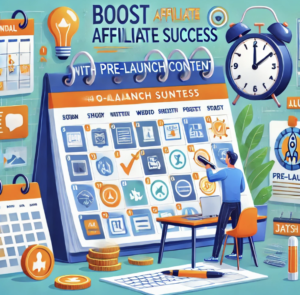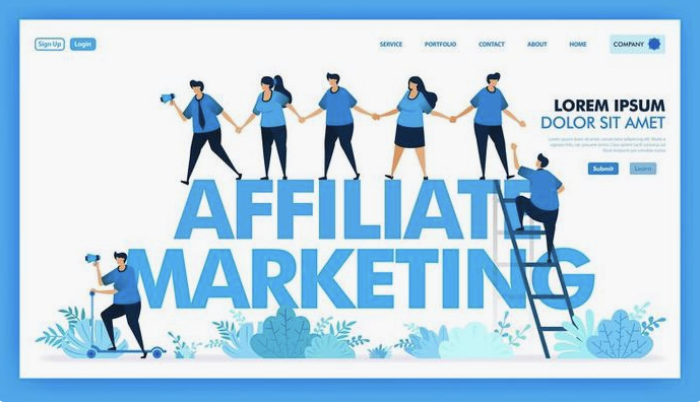How to Boost Affiliate Income with These 24 Tips
We may earn money or products from the companies mentioned in this post.
Learn how to increase your affiliate income effectively with these 24 proven tips that can help you maximize earnings and reach your financial goals faster.
Affiliate marketing is a powerful revenue stream that allows content creators to earn commissions by promoting products or services they genuinely believe in.
It’s a simple concept
You share links to products, and when your audience makes a purchase through those links, you earn a percentage of the sale.
This model benefits creators in almost any niche, from tech enthusiasts reviewing the latest gadgets to travel influencers sharing must-have gear, and even food bloggers recommending kitchen essentials.
For creators, affiliate marketing offers a way to monetize content without the need to develop products, handle inventory, or manage customer service.
It can turn a hobby or passion project into a profitable venture, while still giving the audience authentic recommendations and insights.
And with the right strategies, affiliate marketing can become a sustainable, scalable income source, letting creators focus on what they love—creating content.
How to Boost Affiliate Income
Essential Tips to Boost Your Affiliate Marketing Success
This guide explores 24 proven strategies to help you boost your affiliate marketing performance and increase your earnings.
From choosing the right products to building trust with your audience, each tip is crafted to make a real impact on your results.
These insights will help you improve your approach, increase clicks, conversions, and boost affiliate revenue.
Here are 24 tips to help you boost your affiliate income
1. Understand Your Audience – Know what your audience needs and tailor your affiliate promotions accordingly.
2. Choose High-Quality Products – Only promote products you genuinely believe in and that align with your brand.
3. Use Multiple Affiliate Programs – Diversify your income by joining multiple affiliate programs to avoid dependency on a single source.
4. Leverage SEO – Optimize your content with relevant keywords to attract organic traffic.
5. Focus on Long-Tail Keywords – Target specific, intent-based keywords to capture ready-to-buy users.
6. Create Comparison Articles – Write posts comparing similar products to help readers make informed choices.
7. Write In-Depth Product Reviews – Provide detailed reviews with pros, cons, and personal insights to build trust.
8. Utilize Social Media – Promote affiliate products on platforms like Instagram, Pinterest, and Twitter.
9. Build an Email List – Grow an email list and share affiliate promotions with a dedicated, engaged audience.
10. Use Pop-Ups and Banners – Strategically place pop-ups and banners on your site to highlight affiliate products.
11. Incorporate Call-to-Actions (CTAs) – Use clear, persuasive CTAs to encourage clicks on affiliate links.
12. Create How-To Guides and Tutorials – Help users understand how to use products effectively.
13. Offer Exclusive Deals and Discounts – If possible, provide discount codes for affiliate products to increase conversions.
14. Monitor Trends in Your Niche – Stay on top of trending products or topics to attract current interest.
15. Use Video Content – Create product review videos or tutorials to engage visual learners.
16. Add Affiliate Links to Older Content – Revisit old posts and add relevant affiliate links where applicable.
17. Optimize for Mobile – Ensure your site and affiliate links work seamlessly on mobile devices.
18. Link to Localized Pages – Use links that direct international visitors to relevant regional pages.
19. Run Ads for High-Performing Posts – Invest in ads to boost traffic to your best-converting affiliate content.
20. Utilize Seasonal Content – Create posts tailored to shopping seasons like holidays or back-to-school.
21. Experiment with Different Content Formats – Try using lists, infographics, or interactive quizzes to engage users.
22. Build Trust with Transparency – Always disclose affiliate relationships to maintain credibility.
23. Track and Analyze Performance – Regularly review metrics like click-through rates and conversion rates to optimize strategy.
24. A/B Test Affiliate Link Placement – Experiment with link placements to find the spots that drive the most clicks.
By applying these 24 tips, you can significantly increase your affiliate earnings and foster a loyal, engaged audience.
Launch Your Affiliate Site with Existing Content

Building a solid content library before launching an affiliate site is essential for long-term success.
This initial collection of articles, reviews, tutorials, and guides serves as the backbone of your site, allowing you to establish authority, credibility, and audience trust from day one.
With a robust content library, visitors immediately see that you’re a knowledgeable, reliable source, making them more likely to stay, explore, and return.
Plus, a well-rounded foundation of content helps you rank for multiple keywords, attracting organic traffic and increasing your chances of conversions.
Establishing Credibility with New Visitors
When visitors land on your site, they’re looking for clues that show you know your stuff and that you’re here to stay.
A well-curated content library is one of the strongest signals you can send.
Imagine it as a first impression that says, “I’ve got plenty of knowledge to share, and I’m committed to helping you find what you need.”
When visitors see a range of valuable, informative content, covering different topics in depth, they’re encouraged to stay longer and explore further.
Your content’s depth assures visitors seeking answers or insights that they are in the right place for quality information.
A comprehensive library tells visitors that you’re invested in your niche and that they can rely on you as a credible source.
It’s not just about quantity, either; quality plays an equally critical role.
Thoughtful, well-organized content demonstrates a commitment to providing real value, which builds trust.
As they browse, visitors are more likely to recognize you as an authority they can turn to—someone dedicated to serving their interests.
In turn, this engagement can lead to a loyal audience, with visitors returning because they know they’ll find helpful information on your site.
Ultimately, a content-rich library does more than inform; it lays the groundwork for lasting relationships with readers who view you as a go-to resource in your field.
Why a Rich Content Library Drives Affiliate Success

Without a well-developed content library, a new affiliate site may appear sparse or even unreliable, causing visitors to leave before they truly engage.
When a site lacks depth, visitors may feel uncertain about its credibility, especially if they’re looking for in-depth guidance or product insights.
Think of it this way: a comprehensive content library not only keeps visitors on your site longer but also reassures them that you’re invested in providing value.
This is crucial for an affiliate site, where trust and authority are everything.
Visitors are more likely to follow your recommendations and explore products or services if they feel confident in your expertise.
On the flip side, a site with limited content can feel transactional, as though it’s more focused on quick clicks than on helping the reader make informed decisions.
This can lead to higher bounce rates, as visitors quickly move on to a site that offers the depth and credibility they’re after.
In today’s online space, where countless affiliate sites compete for attention, a well-stocked content library helps your site stand out as a dependable resource.
Additionally, having a range of articles on various topics within your niche strengthens your SEO game.
More content means more opportunities for search engines to index your site, making it easier for potential visitors to find you.
Over time, a rich library boosts your visibility and ranking, allowing you to reach a broader audience and generate organic traffic.
Ultimately, investing in a robust content library not only builds trust but also enhances the site’s longevity.
It signals to visitors that your site is here to serve, inform, and guide, building a reputation that encourages return visits and fosters a loyal audience.
1. Improving SEO and Attracting Organic Traffic

Search engines favor websites that offer substantial, high-quality content.
The more informative, well-researched, and valuable your content is, the more likely it is that search engines will recognize your site as a credible source.
This can lead to higher visibility in search results, driving more organic traffic to your site.
By launching with multiple articles, you significantly boost your chances of ranking for a range of keywords.
Each piece of content provides an opportunity to target different search terms, cover various topics within your niche, and attract diverse audiences.
This not only increases your site’s reach but also strengthens its authority in the eyes of search engines like Google.
A broad content base also allows you to interlink articles, improving your site’s structure and making it easier for search engines to crawl and index your pages.
This can further enhance your SEO performance, as search engines value well-organized sites with clear topic clusters.
Furthermore, having a range of articles from the start can give visitors a reason to explore your site more deeply.
When users spend more time on your site, it signals to search engines that your content is engaging and relevant, which can positively influence your rankings.
Establishing a solid content foundation early boosts SEO success, aiding in site traction, authority, and organic traffic growth.
2. Boost SEO with a Strong Content Foundation

Search engines favor websites that offer substantial, high-quality content.
The more informative, well-researched, and valuable your content is, the more likely it is that search engines will recognize your site as a credible source.
This can lead to higher visibility in search results, driving more organic traffic to your site.
By launching with multiple articles, you significantly boost your chances of ranking for a range of keywords.
Each piece of content provides an opportunity to target different search terms, cover various topics within your niche, and attract diverse audiences.
This not only increases your site’s reach but also strengthens its authority in the eyes of search engines like Google.
A broad content base also allows you to interlink articles, improving your site’s structure and making it easier for search engines to crawl and index your pages.
This can further enhance your SEO performance, as search engines value well-organized sites with clear topic clusters.
Furthermore, having a range of articles from the start can give visitors a reason to explore your site more deeply.
When users spend more time on your site, it signals to search engines that your content is engaging and relevant, which can positively influence your rankings.
Establish a solid content base early on for lasting SEO success, boosting site authority and attracting organic traffic consistently.
3. Delivering Value Throughout the Purchase Process

While some are searching for tutorials or comparing items, others may be in the research stage.
By having a diverse content library, you can cater to each stage of the buyer journey—building trust with those still researching and nudging those ready to buy toward affiliate links.
This versatility encourages visitors to return to your site for a variety of needs, helping to build a loyal, engaged audience.
By providing content for various customer journey stages, your site becomes a valuable resource for users researching, comparing, or ready to purchase.
Establish trust, making your site the reliable choice for information, encouraging return visits for insights and recommendations.
Over time, this loyalty can translate into higher engagement, more conversions, and stronger word-of-mouth referrals as satisfied visitors share your content with others.
4. Enhancing Monetization Opportunities
With more content, you have additional opportunities to strategically place affiliate links where they make the most sense, enhancing both relevance and user experience.
Each piece of content becomes a potential touchpoint, increasing the likelihood that visitors will engage with your affiliate links and, ultimately, make a purchase.
Spreading links across different articles helps integrate them naturally, guiding readers to valuable products or services.
Additionally, covering a broader array of topics allows you to attract a wider audience with diverse interests and needs.
This creates more flexibility to work with a range of affiliate partners, offering products or services that align well with each specific topic.
You can work with affiliates in financial advice and tech reviews to grow earnings and reach a wider audience base.
Tailor content for different buyer journey stages with strategic affiliate links to capture visitors effectively.
This method boosts user trust and conversion rates by guiding visitors with helpful and relevant recommendations.
In short, a robust content strategy with well-placed affiliate links can serve as a powerful revenue stream, giving you both reach and relevance in your affiliate marketing efforts.
5. Maximize Affiliate Link Exposure

Having multiple pages and articles creates numerous entry points for your affiliate links, which can significantly increase their visibility and click-through potential.
Each article you publish is a doorway into your site, providing visitors with a direct route to content that’s relevant to their interests.
Linking internally to affiliate pages helps readers move between related topics, engaging them and increasing the likelihood of encountering affiliate links.
External backlinks from other websites amplify this effect.
When reputable sites link to your content, they’re endorsing your site as a reliable source, which can drive more visitors to your pages.
These backlinks can expand your reach to new audiences, bringing in traffic that’s already primed for the information—and affiliate links—you provide.
Social media shares add another layer of exposure.
Every time someone shares your article, it can attract new readers who may be interested in the products or services you recommend.
By optimizing your content for social sharing, you not only increase the chances of getting affiliate link clicks but also broaden your audience in a natural, engaging way.
This cross-channel approach leverages every possible entry point, increasing both site traffic and the overall effectiveness of your affiliate marketing efforts.
In essence, the more diverse your content and the greater your reach, the more opportunities you create for readers to discover, engage with, and act on your affiliate recommendations.
6. Boost Affiliate Success with Backlinks & Shares

External backlinks from other websites amplify this effect.
When reputable sites link to your content, they’re endorsing your site as a reliable source, which can drive more visitors to your pages.
These backlinks can expand your reach to new audiences, bringing in traffic that’s already primed for the information—and affiliate links—you provide.
Social media shares add another layer of exposure.
Every time someone shares your article, it can attract new readers who may be interested in the products or services you recommend.
By optimizing your content for social sharing, you not only increase the chances of getting affiliate link clicks but also broaden your audience in a natural, engaging way.
This cross-channel approach leverages every possible entry point, increasing both site traffic and the overall effectiveness of your affiliate marketing efforts.
The broader your content’s diversity and reach, the more chances for readers to find and act on your affiliate suggestions.
7. Strengthen Partnerships with Quality Content

When reaching out to affiliate programs or potential partners, having a well-developed content portfolio can give you a distinct edge.
Brands and companies are more likely to partner with sites that appear established, professional, and committed to providing value to their audience.
A robust content library serves as proof of your dedication to the niche, showing potential partners that you’re invested in both the quality and consistency of your site’s offerings.
This reassures them that their products or services will be showcased in a credible and engaging environment, making them more inclined to collaborate with you.
A solid content portfolio doesn’t just open doors to new partnerships; it can also strengthen your bargaining position.
Brands appreciate quality and site engagement, leading to better terms like higher commissions or performance bonuses.
You may even be able to negotiate exclusive discounts, deals, or unique promotions specifically for your audience.
These incentives make your site more attractive to visitors, who will see added value in buying through your affiliate links rather than going elsewhere.
This type of preparation positions you as a professional partner who can drive results.
Establish authority by connecting with trusted brands, boosting reputation among visitors who value consistency in top options and deals.
A robust content portfolio helps attract affiliates and boosts your marketing strategy by establishing your site as a trusted source for recommendations, offers, and insights.
8. Boost Affiliate Success with Pre-Launch Content

Building a rich content library before launching your affiliate site isn’t just a time-saver; it’s a strategic move that sets you up for sustainable growth and a streamlined workflow.
With solid pre-launch preparation, you’re not left scrambling for ideas after going live.
You use a content calendar with proven topics and post types to create quality content without always brainstorming new ideas.
This blueprint gives your site a strong start and provides a clear path to continue expanding your content library over time.
Having a steady flow of content planned also allows you to publish consistently—a critical factor for both audience engagement and SEO.
When visitors see that you’re regularly posting fresh, relevant content, they’re more likely to return, knowing they can rely on your site for updated information.
Consistency builds audience loyalty, as people come to trust that you’ll be there with insights, recommendations, and solutions.
At the same time, search engines favor active sites that continually add new, valuable content.
This steady stream signals that your site is relevant, potentially boosting your search rankings and making it easier for new users to discover you.
The benefits extend to other areas as well.
A rich content library strengthens your credibility and authority in the niche, making you an appealing partner for affiliate programs.
With an established library, brands can recognize your commitment and platform’s reach, leading to improved partnerships and exclusive deals.
This translates to increased monetization potential as your audience grows, driven by both strong SEO performance and a trustworthy reputation.
In short, investing time into pre-launch content planning means that your site will be primed to attract traffic, engage visitors, and drive conversions right from day one.
This foundation streamlines scaling and optimizing affiliate strategy, freeing you from basic content creation and setting you up for success in SEO, audience retention, and revenue generation.
9. Own the Relationship with Your Audience

Direct engagement with your audience is one of the most powerful tools for an affiliate marketer.
By actively interacting with your followers and understanding their needs, preferences, and pain points, you can tailor your content and product recommendations more effectively.
Building an email list amplifies this engagement, allowing you to connect directly with your audience on a personal level.
With an email list, you can nurture relationships over time, offer exclusive content, and share personalized recommendations that build trust and loyalty.
This approach not only strengthens audience connections but also ensures a more stable, long-term relationship that isn’t solely reliant on search or social media traffic.
Through regular email updates, you can keep subscribers informed about new products, special promotions, and exclusive offers, which increases the likelihood of conversions.
Plus, email communication allows you to gather insights into what your audience truly values, helping you refine your content and affiliate strategy based on real feedback.
10. Promote Products Your Audience Loves

Choosing affiliate products that align with your audience’s preferences is key to building trust and driving conversions.
By listening to their feedback—whether through comments, social media, or email responses—you can identify the types of products and services that genuinely address their needs.
For instance, Michael Keenan’s freelance community exemplifies this approach.
Keenan is an affiliate for tools and services catering to freelancers, like project management and invoicing platforms that address their unique challenges.
This alignment between affiliate offerings and audience needs not only made his recommendations more relevant but also led to higher engagement and trust.
When you become an affiliate for products your audience already wants or needs, your content becomes a natural extension of their interests.
Instead of feeling like a sales pitch, it feels like valuable, tailored advice from a trusted source.
Over time, this strategy can lead to higher click-through rates and conversions because the products are directly relevant to your audience’s day-to-day lives and challenges.
11. Master the Products You Recommend

To build credibility and influence as an affiliate, it’s essential to know the products you recommend inside and out.
Thorough product knowledge helps you provide honest, in-depth reviews and address specific questions or concerns your audience may have.
It shows that you’re not just promoting a product for the sake of earning commissions but that you genuinely believe in its value.
A great example of this approach is the success story of the Ebike Generation founder, who built a following by specializing in electric bikes.
Instead of simply linking to various e-bike models, they dove deep into each product’s features, benefits, and potential drawbacks, providing readers with comprehensive insights.
By becoming a true expert in e-bikes, the founder established a strong reputation for reliable information, which led to increased conversions and brand loyalty.
When readers trust that you know the product well, they’re more likely to trust your recommendation—and ultimately make a purchase.
12. Use Audience Insights to Tailor Your Affiliate Strategy
Direct audience engagement and product knowledge allow you to personalize your affiliate approach further.
Through regular interactions and feedback, you gain insights into what resonates most with your readers, from specific product features they value to content formats they prefer.
This data can assist in optimizing your affiliate content by enhancing reviews, guides, and product demonstration videos.
By using audience insights to shape your affiliate strategy, you’re not only improving the quality of your recommendations but also increasing your chances of conversions.
Personalized content feels more authentic and demonstrates that you genuinely understand your audience, making it easier to build long-term loyalty and credibility.
Prioritize direct engagement, email lists, and audience-matched product suggestions for a successful affiliate strategy.
This approach builds loyalty, enhances credibility, and increases conversions, making it a winning formula for sustainable affiliate success.
Leveraging Platforms and Content Types
13. Become a Creator on Instagram

Why Instagram?
Instagram has grown into one of the most popular platforms for influencer marketing, making it an excellent channel for affiliate marketers.
With its visually-driven format, Instagram allows you to showcase products through eye-catching images, engaging videos, and stories that draw in your audience.
Sign up as a creator on Instagram to access special tools such as analytics and branded content to improve your affiliate marketing approach.
Leveraging Instagram’s Creator Tools:
Instagram’s creator tools include insights that help you understand your audience better and see which posts resonate most.
With a creator account, you can track engagement metrics such as clicks on affiliate links, helping you refine your strategy to focus on high-performing content.
Additionally, you can use Instagram Stories and Reels for short, engaging content that showcases products in action, linking directly to affiliate pages for quick conversions.
Engagement Tactics:
Building a following that trusts your recommendations is key.
You can boost engagement by creating polls, Q&As, and live sessions where followers can ask questions and get honest feedback on products you’re promoting.
This personal interaction builds credibility and increases the likelihood that your followers will make purchases through your links.
14. Write Product Reviews and Tutorials

The Influence of Reviews and Tutorials:
Consumers often rely on reviews and tutorials to make purchasing decisions, especially for products they haven’t tried before.
By providing in-depth reviews and tutorials, you can become a trusted source of information, giving your audience the confidence to purchase through your affiliate links.
15. Creating Value with Detailed Insights:
Effective reviews are transparent and cover the pros and cons of a product, its unique features, and how it compares to alternatives.
Tutorials, on the other hand, allow you to demonstrate the product’s benefits and show how to use it, especially for tech or lifestyle items.
This added layer of detail makes it more likely for your audience to view you as an authority and to trust your recommendations.
SEO Benefits:
Optimizing reviews and tutorials for search engines can also drive organic traffic.
By including keywords that relate to the product and its features, you increase the chances of ranking for search terms like “best [product name]” or “[product name] review.”
This approach helps capture traffic from users who are already interested in purchasing, increasing conversion potential.
16. Try Comparative Formats
Helping Consumers Decide Between Options:
Comparison pages are incredibly useful for consumers who are on the fence between two or more products.
By presenting side-by-side comparisons, you help your audience weigh the pros and cons of each product, making their decision-making process easier.
This type of content can drive conversions by guiding visitors towards a final choice, often leading them to click on your affiliate links for one or both options.
Building Trust with Objectivity:
When done well, comparison pages are seen as more objective and helpful, as they provide a balanced view of different products.
You can cover multiple angles like pricing, features, usability, and target audience, giving your readers a comprehensive understanding of each product.
This objectivity helps foster trust, especially if you include affiliate links for both options and allow the reader to make the final choice.
Examples of Effective Comparisons:
You could compare similar products like two fitness trackers, or contrasting options, like different email marketing tools.
In both cases, including links for each product makes it easy for readers to click through and purchase, no matter which one they choose.
17. On-Page Summaries and Roundups

Quick, Digestible Information for Busy Readers:
Consider adding a brief summary or roundup at the beginning of your content to engage time-strapped visitors and provide quick information.
By placing an affiliate link in this summary, you increase the chances that they’ll click through without needing to scroll further.
Improving User Experience and Engagement:
Summaries and roundups condense key information into bite-sized sections, which keeps readers engaged and reduces bounce rates.
A well-organized roundup also appeals to readers looking for variety, allowing you to showcase multiple products at once.
This format is particularly effective for “best of” lists, such as “Top 10 Kitchen Gadgets” or “Best Travel Accessories,” where you can provide a list of options with individual affiliate links.
Enhanced SEO Benefits:
On-page summaries and roundups also help with SEO.
Structuring content with a brief summary at the top can boost search engine ranking by providing quick answers.
Including relevant keywords within the summary can further boost your chances of appearing in “featured snippets” on Google.
Each of these strategies has unique advantages and can help you increase visibility, build trust, and improve conversions, driving more revenue from your affiliate marketing efforts.
By leveraging these methods, you make it easier for readers to find value in your content—and for you to gain loyal, engaged followers who rely on your recommendations.
18. SEO and Search Intent Strategy

Consider Search Intent
Comprehending Search Intent and Its Types:
An individual’s search intent is the underlying goal or motivation driving their query.
It reflects what they’re hoping to achieve by typing certain words into a search engine—whether it’s to gather information, compare options, make a purchase, or find a specific website.
Recognizing this intent allows you to create content that directly addresses what the user needs or is looking for, ultimately making your content more useful and relevant.
By aligning your content with search intent, you can better connect with your audience and deliver value in a way that meets their expectations.
For instance, those looking for “best laptops for students” seek a guide with recommendations, while those searching “how to clean a laptop” want a step-by-step tutorial.
Crafting content that precisely matches these needs increases the chances of engagement, builds trust, and enhances the likelihood of conversions if affiliate links are involved.
The following are examples of common search intent types:
Informational Intent:
Users look for information or answers to particular queries. For example, a search like “how to use a DSLR camera” shows informational intent.
Transactional Intent:
Users are ready to make a purchase and are searching for specific products, often with phrases like “buy,” “best price,” or “[product name] discount.”
Commercial Investigation:
Users are researching products but haven’t decided which one to purchase. Search phrases like “best DSLR cameras for beginners” fit into this category.
19. Navigational Intent in Affiliate Marketing

What is Navigational Intent?
Navigational intent refers to users searching for a specific brand, website, or page, like “Nike official store” or “Amazon login.”
How Can Affiliate Marketers Leverage Navigational Intent?
Affiliate marketers can capture navigational intent by creating content that complements brand-specific searches.
For example, you could write product reviews, brand comparisons, or “best deals” guides related to popular brands.
Examples:
Branded Reviews:
Review popular products (e.g., “Samsung Galaxy S22 review”) to attract users interested in specific brands.
Comparison Articles:
Offer comparisons like “Apple AirPods vs. Bose Earbuds” to provide alternatives.
Deal Pages:
Create “Best Deals” pages for popular retailers, guiding users through affiliate links.
Navigational intent allows affiliate marketers to tap into brand-focused searches with relevant content, boosting engagement and conversions.
20. Content Creation to Align with User Intent

Aligning your content with search intent increases the chances of capturing high-conversion traffic.
Heres how:
Informational Content:
Write guides, tutorials, and how-tos that educate users without pushing them to buy. This content builds trust, positioning you as an authority in your niche.
Transactional Content:
For users ready to buy, create product-specific content like “top-rated DSLR cameras under $500” or “where to buy Canon lenses.”
These posts attract visitors who are already close to making a purchase, which means theyâre more likely to click on affiliate links.
Commercial Content:
Comparison articles, such as “Canon vs. Nikon for Beginners,” or buying guides for specific needs help users in the research phase decide on the best choice, guiding them toward an eventual purchase.
Keyword Research and Search Intent Matching:
Keywords reflect the users intent, so researching keywords that align with each type of search intent is crucial.
For instance, long-tail keywords like “best DSLR cameras for travel” indicate a mix of commercial and transactional intent.
Tools like Ahrefs, SEMrush, and Google Keyword Planner assist in finding intent-focused keywords to reach your target audience effectively.
SEO and User Experience Benefits:
Content aligned with search intent improves both user satisfaction and SEO.
Visitors stay longer on pages that answer their specific needs, leading to lower bounce rates and higher engagement.
Search engines reward this alignment with better rankings, helping your content appear in front of more interested users.
For affiliate marketers, capturing the right intent means driving traffic thats more likely to convert, increasing potential revenue.
21. Keep an Eye on Trending Topics

Why Staying on Top of Trends is Crucial for Affiliate Marketing:
Consumer interest is constantly evolving, influenced by current events, social media trends, and seasonal factors.
Being aware of these trends allows you to produce timely, relevant content that attracts attention when interest is at its peak.
Covering trending topics increases your chances of capturing fresh traffic, as users are more likely to search for content on the latest products or popular subjects.
Finding Trending Topics with the Help of Tools:
Tools like Google Trends, BuzzSumo, Exploding Topics, and Twitter Trends can help you track whats popular in your niche.
Google Trends, for instance, shows interest levels for specific keywords over time, along with related search terms.
BuzzSumo highlights the most shared content on social media, giving you a sense of topics that engage users.
Exploding Topics surfaces rapidly growing trends in various industries, helping you get ahead of the curve.
By using these tools, you can discover emerging topics before theyre oversaturated, making it easier to rank for relevant keywords.
Adapting Content to Seasonal and Niche-Specific Trends:
Certain trends occur around specific seasons, holidays, or events.
For example, fitness and wellness topics peak around New Years, while outdoor gear becomes more popular in spring and summer.
Creating content that aligns with these seasonal trends allows you to tap into the natural surge in interest, making it easier to drive conversions.
For niche-specific trends, following influencers or industry news sources can reveal emerging products or ideas that resonate with your audience.
Updating Existing Content for Continued Relevance:
In addition to creating new content, updating existing articles to reflect current trends can keep your site relevant.
For example, if you wrote a best laptops guide last year, updating it to include newly released models keeps it useful and appealing to readers.
Search engines also reward refreshed content, so regular updates can improve your rankings and keep your traffic steady.
Creating Shareable Content on Trending Topics:
Trend-based content often generates higher engagement on social media, as users are drawn to share timely information.
For example, if a new kitchen gadget goes viral on TikTok, publishing a review or tutorial on it can quickly attract views.
Including affiliate links within this trend-based content allows you to capture the conversions while the trend is still popular.
Make sure to follow all affiliate guidelines for disclosure to maintain credibility and avoid violating any terms of service.
SEO Advantage of Trend-Driven Keywords:
Creating content around trending keywords can help you rank faster due to lower competition, attracting significant traffic during peak periods.
By updating content with new keywords regularly, your site remains dynamic for search engines, engaging both new and returning visitors effectively.
When incorporating these strategies, remember to produce content thats entirely your own to avoid plagiarism.
Paraphrase any ideas you gather from sources and add your unique insights to differentiate your work.
Cite any statistics or quotes directly, and avoid copying entire sections from other sources, even if they’re in the public domain.
Not only does this ensure compliance with copyright laws, but it also helps your content rank better since search engines prioritize original content.
Optimize for Global Reach & Peak Seasons

22. Link to Localized Landing Pages
Why Localization Matters:
Audiences in different regions often have distinct preferences, shopping habits, and even purchasing power.
By linking to localized landing pages, you provide visitors with a personalized shopping experience that feels relevant to their region.
Users are more likely to convert with prices in their currency, local shipping options, and product recommendations reflecting local trends.
Enhancing User Experience with Local Currency and Language Options:
A localized landing page shows prices in the local currency, making the purchasing process smoother and reducing any confusion about conversion rates or additional fees.
For example, if a visitor in the UK lands on a page that shows prices in British pounds instead of US dollars, they’re less likely to abandon the page due to uncertainty.
Some affiliate networks offer dynamic links that detect a user’s location, directing them to the appropriate regional page for a seamless experience.
Matching Product Availability and Local Preferences:
Not all products are available globally, and availability can vary by country.
By directing users to localized pages, you ensure they only see products that are available in their region.
Additionally, preferences differ across regions—winter wear, for example, may be more popular in colder climates, while tropical regions might favor different categories.
Localized pages help you cater to these differences, which can increase the likelihood of conversions.
SEO Benefits of Localized Content:
Creating or linking to region-specific landing pages can improve your SEO performance by targeting local keywords and search behaviors.
Terms targeting specific countries, such as “best running shoes in Canada” or “budget smartphones in India,” boost your local search result ranking chances.
This approach can help you capture organic traffic from global audiences who might otherwise miss your site if it only catered to a generic audience.
How to Implement Localization in Affiliate Marketing:
Some affiliate programs and networks, like Amazon Associates or Rakuten, provide tools to create localized links.
Alternatively, you can work with affiliate partners who offer global reach or ship internationally.
For example, Shopify Collabs and ShareASale often work with brands that serve multiple regions, allowing you to link to relevant landing pages based on your audience’s location.
23. Run Ads During Peak Shopping Seasons

Why Timing Ads with Peak Seasons Increases Conversions:
Peak shopping seasons—such as Black Friday, Cyber Monday, the holiday season, and back-to-school periods—attract high consumer demand and increased online traffic.
During these times, consumers are actively searching for deals and product recommendations, making it an ideal time to run paid ads.
By aligning your ad campaigns with these high-traffic times, you position your affiliate links in front of a more purchase-ready audience, increasing the chances of clicks and conversions.
Choosing the Right Platforms for Seasonal Ads:
The choice of advertising platform depends on where your target audience is most active.
Google Ads, for example, can capture high-intent users searching for specific deals, while Facebook and Instagram ads are effective for visually-driven promotions.
If your audience skews younger, consider platforms like TikTok or Snapchat for seasonal ad placements.
Running ads on these platforms during peak shopping times increases your chances of reaching a large, engaged audience.
Ad Formats and Strategies for High-Impact Seasonal Campaigns:
Discounts and Special Offers:
Ads featuring exclusive discounts or time-limited offers perform well during peak seasons when consumers are looking for deals.
Include affiliate links in your ads to make it easy for viewers to click through and complete their purchase.
Retargeting Campaigns:
Retargeting ads can remind users who previously visited your site or clicked on an affiliate link to complete their purchase.
This strategy is especially effective during peak seasons when users are in the buying mindset.
Product Bundles and Gift Guides:
Create ads promoting product bundles or curated gift guides relevant to the season.
For example, a “Holiday Gift Guide for Tech Lovers” ad that links to a roundup article can drive traffic to your site and highlight multiple affiliate links, maximizing your earning potential.
Budgeting and Bidding Tips for Peak Season Ads:
During peak shopping times, advertising costs can spike due to increased competition.
To optimize your ad spend, consider using a portion of your budget on high-intent keywords or audiences likely to convert.
Setting a daily budget cap or using automated bidding strategies like “Target CPA” can help control costs while still reaching a large audience.
Additionally, plan to allocate more budget for retargeting ads, as these often deliver a higher return on investment by targeting users who have already shown interest.
Tracking and Measuring Ad Performance:
It’s essential to track the performance of your seasonal ad campaigns to understand what resonates with your audience.
Monitor key metrics like click-through rates (CTR), conversion rates, and return on ad spend (ROAS) to assess each ad’s effectiveness.
Most ad platforms offer detailed analytics, and affiliate networks typically provide insights into clicks, conversions, and commissions.
By analyzing this data, you can refine your approach for future peak seasons, focusing on the ad formats, keywords, and strategies that deliver the best results.
Linking to localized landing pages offers personalization for global audiences, while running peak season ads targets deal-seeking buyers effectively.
By combining these strategies, you can enhance user satisfaction and boost commissions by reaching the right audience with relevant content.
24. Report on Affiliate Link Conversions

Why Tracking Affiliate Metrics is Essential:
Tracking the performance of your affiliate links through metrics like clicks, conversion rates, and revenue is critical to understanding whats working and where improvements can be made.
Consistently monitoring metrics provides insights on effective products and strategies, enabling data-driven adjustments for improved performance.
Key Metrics to Track:
The frequency with which users click on your affiliate links.
High click volume indicates attention to content and call-to-actions, but if not leading to sales, refine content or product recommendations.
The percentage of clicks that lead to a sale or other desired action is known as the conversion rate.
A high conversion rate signals relevance and trust, while a low rate may imply a product-audience mismatch or landing page problems.
Revenue:
This metric shows your earnings from each affiliate link. Tracking revenue helps you identify your top-performing products and focus on those, while deprioritizing or replacing low-performing items.
Utilizing Analytics Tools to Gain Comprehensive Understanding:
Affiliate networks typically provide dashboards with these metrics, but additional tools like Google Analytics or specialized affiliate tracking software can offer deeper insights.
For example, you can track user paths to understand how visitors interact with your content before clicking affiliate links.
Setting up goals in Google Analytics lets you monitor affiliate link clicks as conversions, giving you a clear picture of user behavior.
Refining Strategies Based on Data:
Once you identify which links are driving the most conversions, you can optimize future content around similar products or formats.
For example, if comparison articles convert better than standalone reviews, consider creating more comparison-based content.
Additionally, use A/B testing to experiment with different link placements, call-to-actions, and formats to continually improve your results.
The Benefits of Regular Reporting:
Regular reporting keeps you aware of seasonal or trend-based shifts, helping you adjust quickly to maximize conversions.
For instance, a spike in clicks on a particular product may indicate increased interest, prompting you to create more content around it or promote it on social media.
Conversely, if a previously popular product starts underperforming, regular reporting lets you quickly pivot to alternatives.
In summary, tracking affiliate link performance allows you to refine your strategies, make smarter content decisions, and ultimately increase revenue.
Consistently analyzing and adjusting based on these metrics ensures your affiliate marketing approach remains effective and aligned with audience preferences.
Strategic Affiliate Marketing: Pros & Cons

Increased Conversions and Revenue:
Following a strategic approach, such as aligning with search intent and tracking metrics, helps you target a ready-to-buy audience, leading to higher conversions and potentially more income.
Data-Driven Decisions:
By monitoring metrics like clicks and conversion rates, you gain valuable insights that allow you to refine and optimize your strategies over time.
This reduces guesswork and helps you focus on high-performing products and content types.
Better User Experience and Engagement:
Personalizing content with localized landing pages and adapting to trending topics makes your content more relevant to users.
This boosts engagement, builds trust, and improves user experience, which can translate to higher loyalty and return visits.
Competitive Edge:
Keeping up with trends, seasonal shifts, and localized needs allows you to stay ahead of competitors who may not be as responsive to changes.
It also positions you as a knowledgeable, reliable source for your audience.
Long-Term Growth and Learning:
A strategic approach encourages continual learning and experimentation, helping you develop as an affiliate marketer.
This flexibility and adaptability can lead to sustainable, long-term growth in your affiliate revenue.
Cons
Time-Consuming:
Developing and implementing a comprehensive affiliate strategy, from tracking metrics to creating content tailored to search intent, requires significant time and effort.
Regular reporting, A/B testing, and adjusting content can be especially demanding.
Potential Costs with Ads and Tools:
Running ads during peak shopping seasons can be costly, especially with increased competition.
Additionally, premium analytics and tracking tools may incur extra expenses, which could be a barrier for some marketers.
Complexity of Tracking and Analytics:
Analyzing and interpreting data from multiple platforms, such as Google Analytics, affiliate dashboards, and SEO tools, can be challenging.
Misinterpretation of data or lack of familiarity with analytics tools may lead to misguided decisions.
Seasonal and Trend Reliance:
Relying on trends and peak shopping seasons may create fluctuations in traffic and conversions.
If trends shift or ad costs spike, this can impact overall revenue, making it difficult to maintain a stable income.
Risk of Overwhelming Content Variety:
Producing various content types, such as comparison articles, reviews, and seasonal content, can spread resources thin.
This may lead to content inconsistency or diluted focus, especially if you’re managing the affiliate site alone.
FAQ for Strategic Affiliate Marketing

What is the benefit of tracking affiliate link conversions?
Tracking conversions helps you understand which products and strategies perform best with your audience.
By analyzing clicks, conversion rates, and revenue, you can refine your approach to focus on high-performing content and improve overall revenue.
How can I use search intent to increase conversions?
Aligning content with search intent ensures you’re meeting users’ needs at each stage of their buying journey.
For example, creating comparison pages for users researching products or targeting transactional keywords like “buy” for ready-to-purchase audiences can lead to more clicks and conversions.
Why is linking to localized landing pages important?
Localized landing pages show prices in local currencies and adjust content to match regional preferences, making it easier for global audiences to engage.
This personalized experience increases the likelihood of conversions as it feels more relevant and accessible to the user.
How can I keep up with trending topics for affiliate marketing?
Use tools like Google Trends, BuzzSumo, and Exploding Topics to track popular searches and content in your niche.
Creating content around these trends or updating existing content keeps it relevant, drives more traffic, and improves your chances of ranking for high-demand topics.
When is the best time to run paid ads for affiliate links?
Peak shopping seasons, such as Black Friday, holiday sales, and back-to-school, attract high-intent buyers actively searching for deals.
Running ads during these times can maximize exposure and conversions, especially if you promote seasonal or popular products.
Final Thought
A well-planned affiliate strategy has various benefits like higher revenue and improved user experience, but it needs commitment, resource management, and ongoing analysis.
By carefully weighing the pros and cons, you can approach affiliate marketing strategically, balancing effort with reward and paving the way for consistent growth.
Summary
A strategic approach is essential for success in affiliate marketing.
Tracking metrics, optimizing content, following trends, and localizing experiences can boost affiliate engagement and conversions.
These strategies are designed to help you maximize your impact, but experimentation is key—try different approaches to see what resonates best with your audience.
For continued growth, explore additional resources on affiliate marketing and online revenue.
Expanding your knowledge can help you refine your approach, increase revenue, and ensure that your strategies stay effective and aligned with changing audience needs.
Final Words and Encouragement
Keep in mind that affiliate marketing is a process rather than a quick fix.
Each tip you apply is a step toward creating a thriving, sustainable income stream, so don’t be afraid to test, learn, and adjust along the way.
The beauty of this field lies in its flexibility you have the freedom to explore what resonates best with your audience and make meaningful connections.
Stay curious, stay dedicated, and keep your audiences needs at the heart of your efforts.
With persistence and these strategic insights, your affiliate marketing goals are well within reach. Here’s to your success!
By following the strategies in How to Boost Affiliate Income with These 24 Tips, you’ll be well-equipped to enhance your earnings and create a loyal, engaged audience.
Take action on these tips and watch your affiliate income grow!
Thank you for reading, and we hope you find the insights valuable and thought-provoking.
I would much appreciate it if you could kindly leave your comments and questions below.
Thank You For Stopping By Once More
Till The Next Time
Elke
Author






